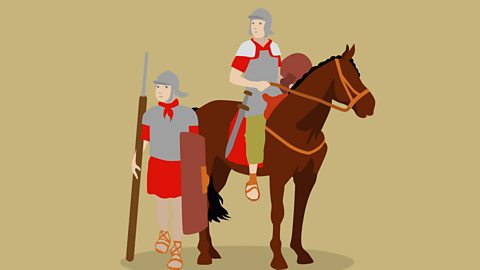Key points
- The Roman Empire extended across a huge area of modern-day Europe, as well as parts of modern-day Africa and Asia.
- The Romans were great innovators and are credited with being one of the earliest civilisations to use concrete, build aqueducts and introduce toilets and heating systems in some towns.
- Life was different for people depending on their social status, wealth and gender.
Family life in the Roman Empire
Members of wealthy families were known as patricians. Men in these families often held powerful roles. For example, they might have been:
- a government official
- a general in the army
- a judge
Patrician families made up the ruling class, meaning they were in jobs that had a lot of influence in how Rome and the empire were ruled.
The majority of the population were known as plebeians and they had to work to support themselves and their families. They had jobs such as:
- soldier
- craftsperson
- shop owner
- farmer

Did you know?
Historians estimate that up to 10 per cent of the population of the Roman Empire were enslaved people. They had no legal rights in ancient Rome and they were considered to be property. They did a wide variety of work, from looking after the home to carrying out skilled crafts.

Religion in the Roman Empire
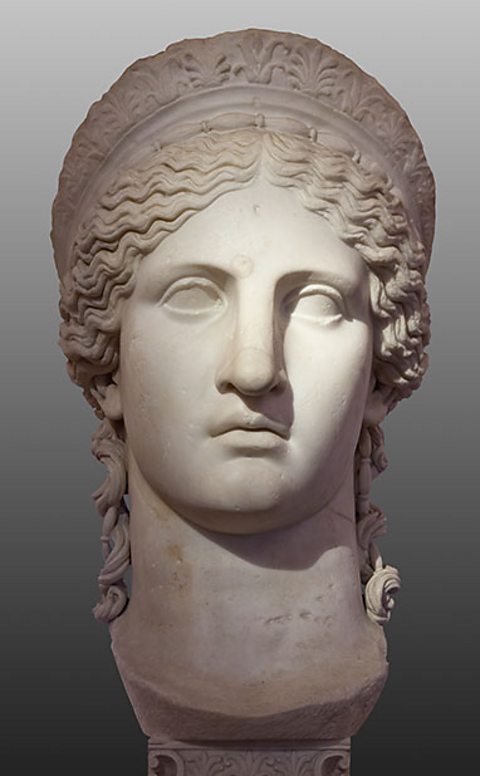
- The Roman Empire was polytheistic - this means that people worshipped more than one god.
- Wealthy and poor Romans shared the same religion ā this was one of the only aspects of life they shared.
- Some of the main gods and goddesses in Roman religion were Jupiter, Juno, and Minerva.
Saturnalia
Enslaved people were allowed a day of not having to work on the religious festival of Saturnalia in December. They would often be served food by their masters in a reversal of usual roles. The festival was held to honour the god Saturn.

Towns and houses in the Roman Empire
Insulae
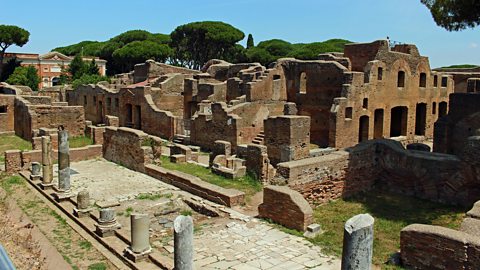
- When the Romans built towns in their provinceAn area of land controlled by the Roman Empire outside of the borders of Rome itself. they built them in the same way as they built towns in Rome.
- Streets were planned out in a grid system which divided the town into blocks known as insulaeThe Latin word for āislandā, used either to refer to the blocks Roman towns were split into to form a grid system, or to the apartment buildings commonly found in towns..
- The word āinsulaā meant island in the Roman language of Latin.

The word insulae was also used to describe the type of apartment building that was common in Roman towns. Plebeians living in a town usually lived in insulae. In the insulae there would often be a shop on the bottom floor, then traders had their living quarters in the upper floor.
Some of the shops traders had on the bottom floor of the insulae were:
- blacksmiths
- barbers
- book shops
- wine shops
- leather shops
Domus
Wealthy people lived in large town houses called domusLarge town houses that wealthy Romans lived in. which typically contained:
- painted walls
- tiled floors
- toilets
- baths
- large gardens
Villas and farms
Wealthy people would also have had large villas in the countryside where they went to get away from the heat and smell of the city. Also in the countryside were ordinary people working in agriculture - producing crops and looking after animals. There was a mix of large and small farms, with large landowners often using enslaved people to work on their farms.
Cicero, a Roman who wrote about life in Rome, said of the work people could carry out, ānone is better than agriculture, none more profitable, none more delightful.ā
Hypocausts
In Roman Britain it was not unusual to find under-floor heating in the large houses of the rich or in bath houseA social area where Romans could meet friends, play board games and wash.. The heat was provided by a system called a hypocaust. It used fire to circulate hot air through spaces under the floors.
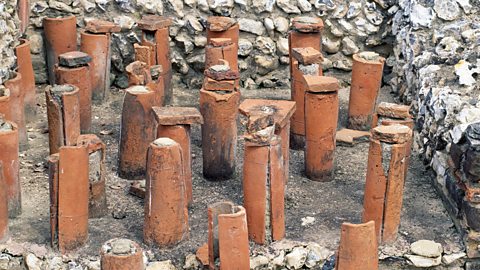
The forum
The forum, was a large public square, which was considered to be the heart of the town. It was the site of lots of aspects of Roman life including:
- public speeches
- criminal trials
- elections
- religious ceremonies
- market trading
Important buildings were constructed near the forum such as Senate houseThe buildings where senators met to discuss laws., basilicaA public building, where law courts were held or other public administration was carried out and temples.
Roman innovations
The Romans were well known for their ideas and inventions. They were some of the earliest users of concrete, which allowed them to build large buildings, with huge domes. One famous domed building was the Pantheon in Rome, which still survives today.
Aqueducts
Aqueducts were stone channels which were normally built on top of stone arches. They carried water from mountain springs and other fresh water sources to towns and cities. A system of aqueducts supplied Rome with millions of gallons of water each day.
Before the Romans came to Britain, most people had never seen stone arches before and their version of an aqueduct- before the Romans arrived - was a channel on the ground.
The Romans improved water supplies throughout the Empire. Aqueducts showed the importance Romans placed on cleanliness and hygiene. The design and construction of these structures illustrated an advanced level of engineering knowledge.
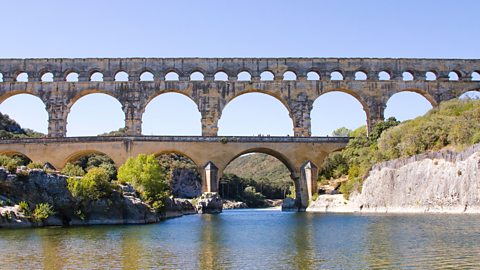
Toilets
Roman toilets had their own plumbing and sewers, sometimes using water from bath houses to flush them. This ensured waste was carried away from where people lived and reduced the risk of certain diseases. The Romans did not have toilet paper. Instead they used a sponge on a stick to clean themselves. A channel of water ran underneath the communal toilets and swept the human waste to the sewer. At home toilets were little pots that were emptied into larger pots.
Roman leisure activities
Bath houses
Every Roman town had public baths which were cheap to enter. Washing and swimming were not the only reason to visit bath houses. They were also places to meet friends, gossip and play board games or dice. bath houseA social area where Romans could meet friends, play board games and wash. quickly became the centre of social life.
In most bath houses there were different rooms with varying temperatures.
- Normally people would start with a lukewarm pool known as the tepidarium.
- Then they would move into the caldarium which was full of steam and hot baths.
- The bathing routine would be finished with a swim in a cold, outdoor pool called the frigidarium.
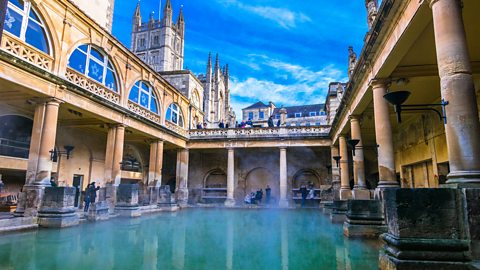
Theatres
Theatres were built throughout the Roman Empire. Their design was usually a semi-circle arrangement of seats around a stage where performances took place.
- Performances often included dances with musical accompaniment.
- Livius Andronicus was a famous Roman playwright whose plays were first publicly performed in 240BCE.
- Comedies and tragedies were popular while other plays focused on Roman history.
The first theatre that was permanently built was the Theatre of Pompey in 55BCE. It was could hold 20,000 spectators.
Amphitheatres, gladiator fights and venationes
The Romans built amphitheatrez8js4qt throughout the empire in modern-day Algeria, Spain, Cyprus, England and France. Amphitheatres were large, outdoor arenas and they were usually built in a circular shape. The space was used for entertainment.
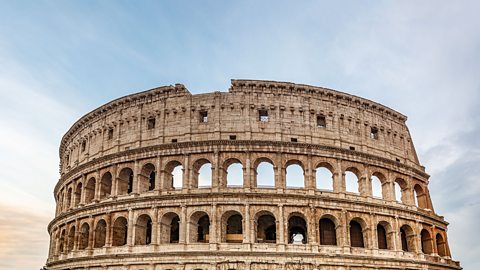
People would go to watch gladiators fight for their lives in theatrical events. The bloodier the battle the more entertained the crowd were. Emperors often arranged elaborate performances and contests to be put on in the ColosseumLocated in Rome, it is the largest ancient amphitheatre. It could hold up to 80,000 spectators., an amphitheatre in Rome, as a way of demonstrating their power and success.
Gladiators
There were different types of gladiators and special schools were set up to train ordinary men as gladiators:
- some were enslaved people
- some were criminals whose punishment was to fight
- others were volunteers who may have volunteered to make money or to achieve celebrity status
The prize money won by any enslaved gladiators went to their master, or owner. They may have given some of the money to the gladiator. People who were no longer enslaved were able to keep any prize money for themselves.
Venationes
Wild animal shows, called venationes, were also a popular type of performance in amphitheatres. Exotic animals such as lions, panthers and elephants showed the wealth of the Empire. Sometimes the animals were placed in staged contests against convicted criminals, enslaved people or hunters. In other contests the animals were killed by gladiators.
Roman clothing
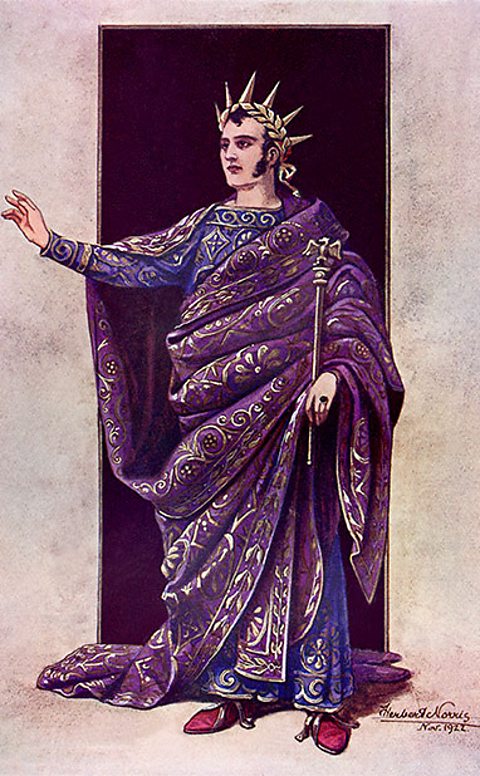
Romans could demonstrate their financial and social status through the clothes they wore.
One thing all Roman citizens had in common was that they wore a tunicA piece of clothing worn by Romans, often under a toga.. This piece of clothing was usually loose fitting and went down to someoneās knees or ankles. It was often worn under a piece of clothing called a togaA large piece of material that wealthy Romans wore - it was draped over the shoulders and around the body..
The toga, a large piece of cloth that was draped over a tunic, acted as a status symbol. It was heavy and this made it hard for the wearer to move quickly. This meant it wasnāt practical for poorer workers to wear as they carried out manual labour.
Even the colour of someone's toga showed wealth and status - senators were allowed to wear a purple band around their toga. At times during the era of the Roman empire, only the emperor was allowed to dress all in purple.

Why did colour purple represent power?
Purple dye was difficult and expensive to make. It was costly, which is probably the reason it was associated with powerful people in Rome. The dye was made from the sea snails found in the Mediterranean Sea. The dye-making process was delicate and slow. The colour, produced by the dye, was known as āTyrian purpleā after the town of Tyre on the Mediterranean coast.
Test your knowledge
Play the History Detectives game! gamePlay the History Detectives game!
Analyse and evaluate evidence to uncover some of historyās burning questions in this game.

More on The Romans
Find out more by working through a topic
- count1 of 2
